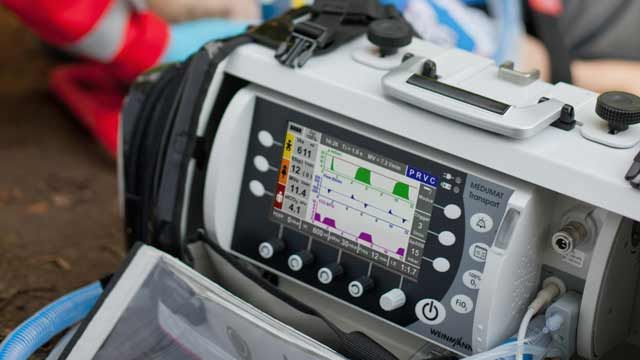Weinmann Develops Life-Saving Transport Ventilator Using Model-Based Design
Challenge
Solution
Results
- Code development and reviews accelerated by 50%
- Dozens of design alternatives explored
- 60% of core design reused
“Modeling, simulating, and implementing the ventilator’s embedded software with Simulink greatly simplified compliance certification. The model helped ensure a structured development process and provided thorough documentation and a visual representation of the system for the certification review.”

The MEDUMAT Transport ventilator moves a mixture of oxygen and air into and out of the lungs of patients who require breathing support. Developed by Weinmann Medical Technology, MEDUMAT Transport is designed for use in emergency care and during transport for intrahospital or interhospital transfers. As an emergency medical device deployed in a wide range of operating conditions, the MEDUMAT Transport must be portable, versatile, and exceptionally reliable.
Weinmann engineers used Model-Based Design with MATLAB® and Simulink® to develop the embedded software for MEDUMAT Transport. This approach not only streamlined production; it also helped Weinmann work with TÜV SÜD to certify MEDUMAT Transport to ISO/IEC 62304, ISO 10651-3, DIN EN ISO 13485, and DIN EN ISO 14971 standards.
“MEDUMAT is orders of magnitude more complex than earlier ventilators that we have developed,” says Dr. Florian Dietz, head of predevelopment emergency medicine at Weinmann. “Model-Based Design with MATLAB and Simulink enabled us to handle the increased complexity, and it was instrumental in our achieving compliance certification. Working with models instead of handwritten code makes the embedded software easier to maintain and reuse, and helps us explain the technology to a certification authority.”
Challenge
Solution
Weinmann used MATLAB and Simulink to model, simulate, and help verify the embedded software for MEDUMAT Transport and to simplify the compliance certification process.
Weinmann engineers developed a Simulink plant model, which included hardware components as well as a mechanical model of human lungs.
The team used Simulink and Stateflow® to model the controller and its state machines, including one state machine that tracks standby, startup, shutdown, and other operating modes and a second that manages the entire ventilation process.
The system-level controller model served as the top level in a hierarchy of subsystems, which were also modeled in Simulink, supporting the fundamental requirement for a modular software design and architecture.
After developing and simulating the design as a floating-point model, the engineers used Fixed-Point Designer™ to convert it to fixed point for deployment to the 16-bit MCU.
In parallel with the MCU development, the engineers used DSP System Toolbox™ to develop digital filters and algorithms for the proximal flow sensor that calculates the gas flow velocity to the patient.
After running closed-loop simulations of the controller and plant in Simulink, the team used Embedded Coder® to generate production code for the control system and the sensor signal processing subsystem. They deployed the code to the Infineon and TI MCUs, respectively.
Weinmann engineers performed unit tests on each subsystem within the model, using Simulink Coverage™ to analyze model coverage.
Most safety standards now explicitly require or recommend the use of Model-Based Design. As a result, Weinman will leverage its investment in MATLAB and Simulink on future projects requiring certification.
MEDUMAT Transport is now in production and in use by medical personnel in Europe, Asia, and Australia.
Results
Code development and reviews accelerated by 50%. “Model-Based Design enabled us to generate 100% of the embedded software, excluding the drivers,” says Dietz. “We also spent about 50% less time on internal review, because we worked with the models instead of low-level source code.”
Dozens of design alternatives explored. “With MATLAB and Simulink we evaluated up to 40 signal processing algorithms, which we could not have done if we were hand coding,” notes Dietz. “In MATLAB we analyzed and plotted the results produced by the different algorithms to identify the best one for our design.”
60% of core design reused. “In developing a next-generation ventilator, which uses a different processor, we will reuse about 60% of the Simulink model for MEDUMAT Transport,” says Dietz. “We estimate that this reuse will reduce development time on the new project by an additional 30%.”